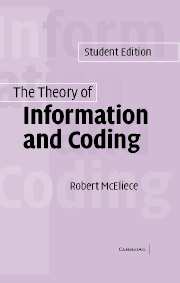Book contents
- Frontmatter
- Contents
- Editor's statement
- Section editor's foreword
- Preface to the first edition
- Preface to the second edition
- Introduction
- Part one Information theory
- Part two Coding theory
- 7 Linear codes
- 8 Cyclic codes
- 9 BCH, Reed–Solomon, and related codes
- 10 Convolutional codes
- 11 Variable-length source coding
- 12 Survey of advanced topics for Part two
- Appendices
- References
- Index of Theorems
- Index
9 - BCH, Reed–Solomon, and related codes
from Part two - Coding theory
Published online by Cambridge University Press: 05 June 2012
- Frontmatter
- Contents
- Editor's statement
- Section editor's foreword
- Preface to the first edition
- Preface to the second edition
- Introduction
- Part one Information theory
- Part two Coding theory
- 7 Linear codes
- 8 Cyclic codes
- 9 BCH, Reed–Solomon, and related codes
- 10 Convolutional codes
- 11 Variable-length source coding
- 12 Survey of advanced topics for Part two
- Appendices
- References
- Index of Theorems
- Index
Summary
Introduction
In Chapter 7 we gave one useful generalization of the (7, 4) Hamming code of the Introduction: the family of (2m − 1, 2m − m − 1) single-error-correcting Hamming codes. In Chapter 8 we gave a further generalization, to a class of codes capable of correcting a single burst of errors. In this chapter, however, we will give a far more important and extensive generalization, the multipleerror-correcting BCH2 and Reed–Solomon codes.
To motivate the general definition, recall that the parity-check matrix of a Hamming code of length n = 2m − 1 is given by (see Section 7.4)
where (v0, v1, …, vn−1) is some ordering of the 2m − 1 nonzero (column) vectors from Vm = GF(2)m. The matrix H has dimensions m × n, which means that it takes m parity-check bits to correct one error. If we wish to correct two errors, it stands to reason that m more parity checks will be required. Thus we might guess that a matrix of the general form
where w0, w1, …, wn−1 ∈ Vm, will serve as the parity-check matrix for a two-error-correcting code of length n. Since however, the vi's are distinct, we may view the correspondence vi → wi as a function from Vm into itself, and write H2 as
But how should the function f be chosen? According to the results of Section 7.3, H2 will define a two-error-correcting code iff the syndromes of the error pattern of weights 0, 1 and 2 are all distinct.
Information
- Type
- Chapter
- Information
- The Theory of Information and CodingStudent Edition, pp. 230 - 292Publisher: Cambridge University PressPrint publication year: 2004
